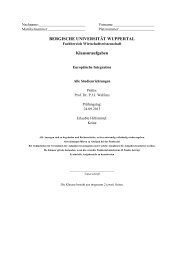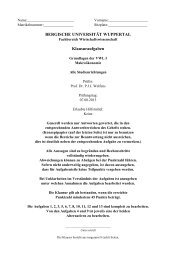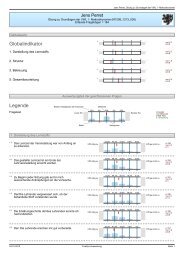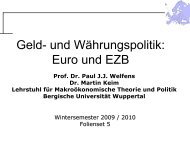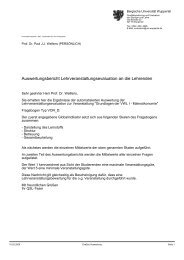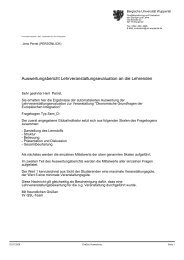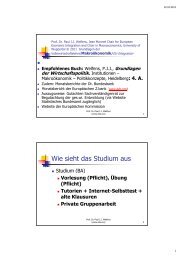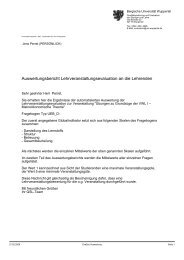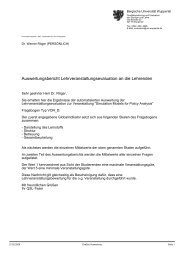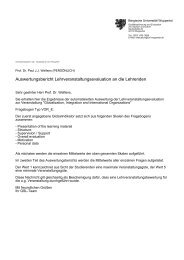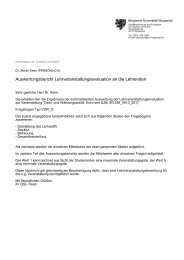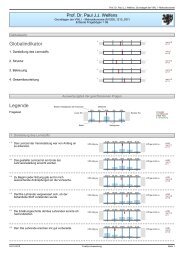UNIVERSITÄT POTSDAM - Prof. Dr. Paul JJ Welfens
UNIVERSITÄT POTSDAM - Prof. Dr. Paul JJ Welfens
UNIVERSITÄT POTSDAM - Prof. Dr. Paul JJ Welfens
Create successful ePaper yourself
Turn your PDF publications into a flip-book with our unique Google optimized e-Paper software.
3.2. Empirical Links Between Innovations and Output<br />
The empirical investigation of the effects of technological change or more generally<br />
innovation on economic growth has produced a voluminous and diverse literature.<br />
Roughly, there are three types of studies: historical case studies, analyses of invention<br />
counts and patent statistics, and econometric studies relating output or productivity to<br />
R&D or similar variables (GRILICHES, 1995). Here, we will confine ourselves to<br />
econometric studies, which use some indicator variables to approximate the impact of<br />
technological change and innovations.<br />
First, one important input factor for technological change and innovation can<br />
serve as a proxy variable: R&D. Most research in this vein uses an augmented Cobb-<br />
Douglas production function which includes some kind of a R&D stock besides the<br />
usual production factors. The coefficient belonging to this R&D stock can then be interpreted<br />
as production or output elasticity of R&D. Alternatively, this kind of production<br />
function is transformed into growth rates, and the R&D intensity (R&D/Y) is included.<br />
The parameter belonging to this R&D intensity yields the rate of return to<br />
knowledge. Similar to these approaches is another procedure where total factor productivity<br />
is calculated first. Then again, either the logs of levels of total factor productivity<br />
are linked to some kind of log R&D stock or the first differences of log total factor<br />
productivity are regressed on the R&D intensity. The interpretation of the estimated<br />
coefficients is the same as before: the regression of the levels of log total factor productivity<br />
on a log R&D stock yields a measure of the elasticity of output to knowledge,<br />
while the regression of total factor productivity growth yields a measure of the social<br />
gross (excess) rate of return to knowledge (GRILICHES / LICHTENBERG, 1984 and<br />
GRILICHES, 1995).<br />
A general problem for the measurement of the effects of R&D on output is that<br />
a number of externalities arise in the innovation process. Summarizing the relevant<br />
literature on this topic, CAMERON (1998) distinguishes between four kinds of externalities.<br />
First, a standing on shoulders effect which reduces the costs of rival firms because<br />
of knowledge leaks, imperfect patenting, and movement of skilled labor to other<br />
firms. In a wider sense international technological spillovers due to foreign trade can<br />
also be considered as within the standing on shoulders effect. Secondly, there exists a<br />
surplus appropriability problem because even if there are no technological spillovers,<br />
the innovator does not appropriate all the social gains from his innovation unless he can<br />
price discriminate perfectly to rival firms and/or to downstream users. Thirdly, new<br />
ideas make old production processes and products obsolescent: the so-called creative<br />
destruction effect. Fourthly, congestion or network externalities occur when the payoffs<br />
to the adoption of innovations are substitutes or complements. This is sometimes called<br />
the stepping on toes effect. The adequate consideration of these effects in empirical<br />
31



